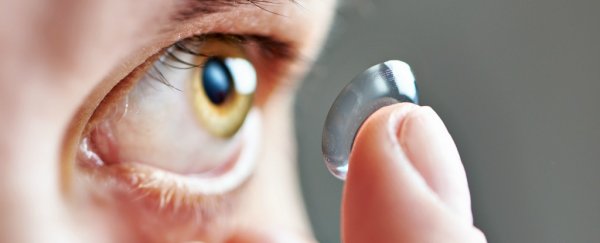When people ask me why I don't wear contacts, I typically come up with some excuse to avoid admitting the truth: that sticking a plastic device directly on the fragile mucous membrane surrounding my cornea terrifies me.
But it does, and it's the reason I've always felt A-OK just wearing glasses.
A new report from the Centres for Disease Control and Prevention makes me feel a little justified in my fear of contacts, despite the fact that they're largely safe and effective - at least when worn correctly.
The report builds on previous findings from 2014, when the CDC found that more than 99 percent of the contact lens wearers they surveyed reported at least one behaviour that put them at risk for an eye infection.
Forty-one million Americans don't share my fear, opting to use contacts on the regular.
According to the new study, which looked at 1,075 reported infections related to wearing contacts, many of these infections can lead to long-lasting damage. On the bright side, they're typically preventable.
Here were their main findings:
About 1 in 5 reports included someone who'd had a scarred cornea, needed a corneal transplant, or had reduced vision.
Roughly 20 percent of the reported infections included someone who'd had severe problems with their cornea, the eye's clear front dome. The cornea plays a key role in clear vision and has a remarkable capacity to recover from most minor nicks.
But an infection - like the ones described in the CDC's report - can damage the cornea's deeper layers, making it tough to completely heal.
In some cases, corneal damage can also cause scarring, which can distort your vision. When the scarring is severe, you may need a corneal transplant, which involves swapping part of your cornea with tissue from a donor.
More than 1 in 4 reports mentioned contact lens habits that are known to increase the chance of getting an infection.
While these problems sound severe, most of them are potentially preventable. For example, the report found that many users reported sleeping in their contact lenses when not prescribed and wearing lenses for longer than the prescribed period.
"Contact lens wearers can reduce their risk for contact lens-related infections by improving their hygiene behaviours, such as not sleeping in contact lenses unless prescribed and replacing their contact lenses as prescribed," the report states.
So next time you get up to put on your contacts, remember - you're putting in a medical device, and you should handle it with care.
Here are some simple tips for good contact lens hygiene:
1. Wash your hands before handling your lenses.
2. Completely replace yesterday's contact solution.
3. Wear your contacts for only as long as they're prescribed.
4. Rinse your lens case with contact solution and wipe it out with a clean towel after every use.
This article was originally published by Business Insider.
